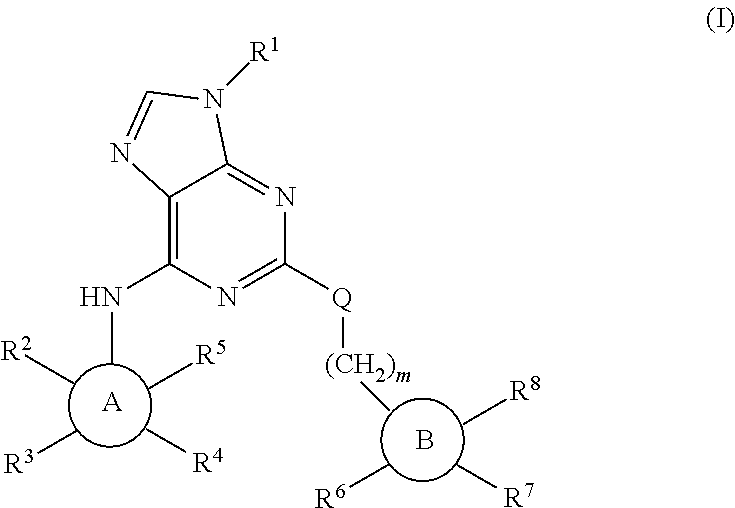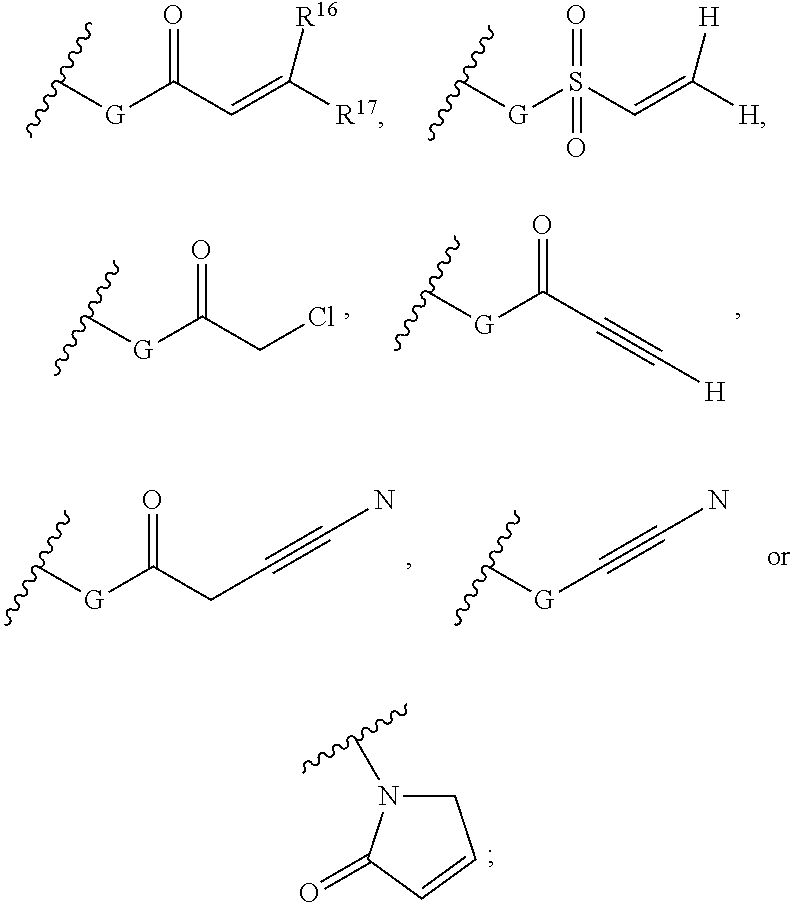Purine derivatives
a technology of derivatives and purines, applied in the field of purine derivatives, can solve the problems of majority of patients who initially respond to develop resistan
- Summary
- Abstract
- Description
- Claims
- Application Information
AI Technical Summary
Benefits of technology
Problems solved by technology
Method used
Image
Examples
example 1
(Scheme A): Preparation of (S)—N-(1-(9-isopropyl-6-((4-(4-methylpiperazin-1-yl)phenyl)amino)-9H-purin-2-yl)pyrrolidin-3-yl)acrylamide
[0581]
Step 1: Preparation of 2,6-dichloro-9-isopropyl-9H-purine
[0582]
[0583]A 500 mL round bottom flask was charged with 2,6-dichloro-9H-purine (1.89 g, 10 mmol), isopropanol (3.1 mL, 40 mmol, 4 mol eq), THF (150 mL), and triphenylphosphine (polystyrene-bound, ˜3 mmol / g, 6.7 g, or about 20 mmol load) and the resulting mixture was stirred and cooled in a water bath under nitrogen. A solution of DBAD (4.85 g, 20 mmol) in THF (50 mL) was added dropwise via an addition funnel over 30 min and the resulting reaction mixture stirred at ambient temperature for 20 hr. The resin was removed by filtration and washed well with ethyl acetate. The combined filtrates were evaporated to give a light yellow solid that was purified via flash column chromatography (dry loaded using silica / DCM) with a gradient of 0-50% ethyl acetate in heptanes to give:[0584]1. The title p...
example 2
(Scheme A): Preparation of N-((3R,4R)-4-fluoro-1-(9-isopropyl-6-((1-methyl-1H-pyrazol-4-yl)amino)-9H-purin-2-yl)pyrrolidin-3-yl)acrylamide
[0595]
Step 1: Preparation of 2-chloro-9-isopropyl-N-(1-methyl-1H-pyrazol-4-yl)-9H-purin-6-amine
[0596]
[0597]2,6-Dichloro-9-isopropyl-9H-purine (1.16 g, 5 mmol), as prepared in step 1 of Example 1, was mixed with 4-amino-1-methylpyrazole (1.02 g, 10 mmol) and DIPEA (1.74 mL, 10 mmol) in nBuOH (33 mL) and was stirred and heated at 100° C. (block temperature) for 1 hr. The reaction was cooled, and the volatiles were removed under vacuum to give a dark residue. Ethyl acetate (120 mL) was added and the mixture was washed with sat. aq. NaHCO3 (3×30 mL), dried over Na2SO4 and evaporated to give a dark residue. This residue was dissolved in ethyl acetate, passed through a thin pad of silica gel, and eluted with 90% ethyl acetate-10% ammonia (7 N in methanol). The eluent was evaporated to afford the title compound as a dark solid (1.43 g, 98% yield). 1H NMR...
example 3
(Scheme B): Preparation of N-(3-((9-isopropyl-6-((1-methyl-1H-pyrazol-4-yl)amino)-9H-purin-2-yl)oxy)phenyl)acrylamide trifluoroacetate
[0618]
Step 1: Preparation of 9-isopropyl-N-(1-methyl-1H-pyrazol-4-yl)-2-(3-nitrophenoxy)-9H-purin-6-amine
[0619]
[0620]To a solution of 3-nitro-phenol (143 mg, 1.03 mmol) in DMF (15 mL) was added sodium hydride (56 mg, 1.4 mmol) slowly and the mixture was stirred at rt for 30 min. 2-chloro-9-isopropyl-N-(1-methyl-1H-pyrazol-4-yl)-9H-purin-6-amine (200 mg, 0.69 mmol), as prepared in step 1 of Example 2, was added slowly. After the addition, the mixture was stirred at 110° C. overnight. The cooled reaction mixture was poured into water (100 mL) and extracted with EtOAc (2×30 mL). The combined organic extracts were dried over Na2SO4, concentrated and the residue was purified by flash column chromatography (MeOH:EtOAc=1:10) to give the title compound (50 mg, 18% yield) as light yellow oil.
Step 2: Preparation of 2-(3-aminophenoxy)-9-isopropyl-N-(1-methyl-1H-...
PUM
| Property | Measurement | Unit |
|---|---|---|
| Cell growth | aaaaa | aaaaa |
Abstract
Description
Claims
Application Information
 Login to View More
Login to View More - R&D
- Intellectual Property
- Life Sciences
- Materials
- Tech Scout
- Unparalleled Data Quality
- Higher Quality Content
- 60% Fewer Hallucinations
Browse by: Latest US Patents, China's latest patents, Technical Efficacy Thesaurus, Application Domain, Technology Topic, Popular Technical Reports.
© 2025 PatSnap. All rights reserved.Legal|Privacy policy|Modern Slavery Act Transparency Statement|Sitemap|About US| Contact US: help@patsnap.com



